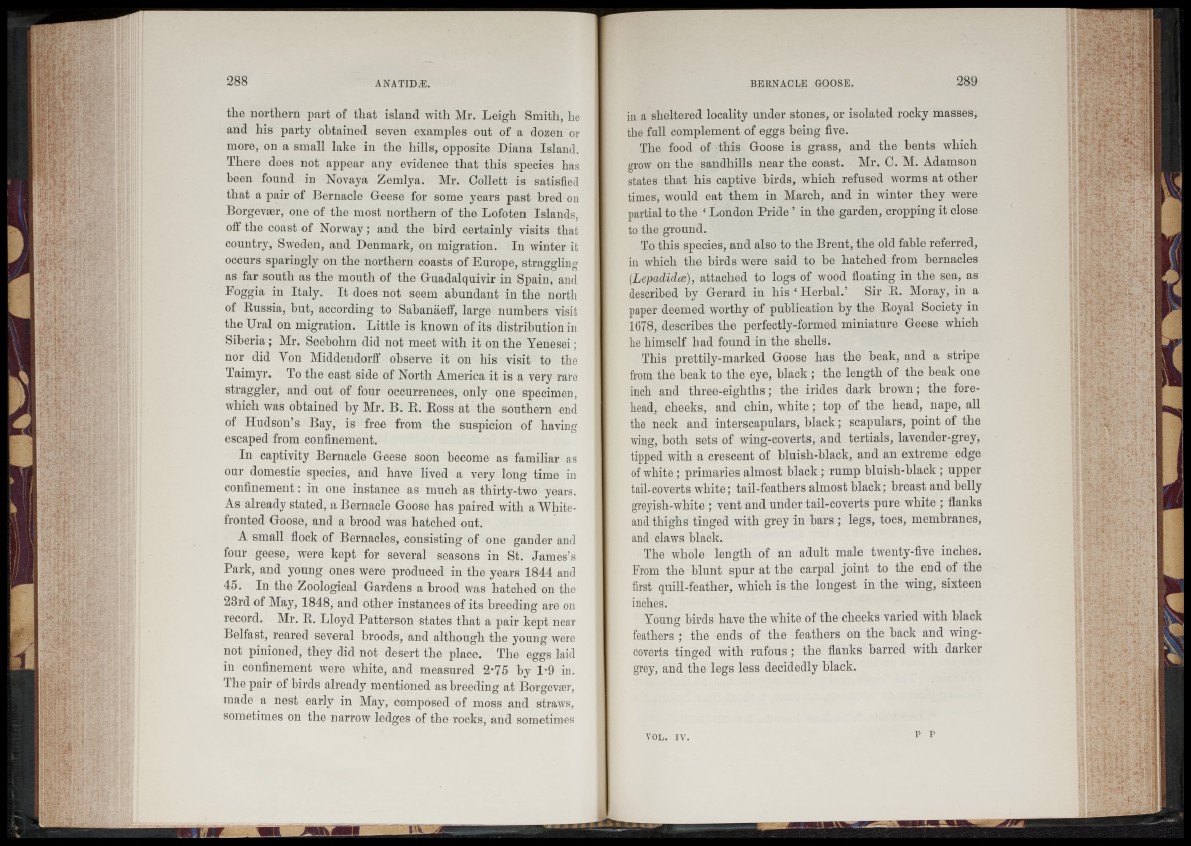
the northern part of that island with Mr. Leigh Smith, he
and his party obtained seven examples out of a dozen or
more, on a small lake in the hills, opposite Diana Island.
There does not appear any evidence that this species has
been found in Novaya Zemlya. Mr. Collett is satisfied
that a pair of Bernacle Geese for some years past bred on
Borgevmr, one of the most northern of the Lofoten Islands,
off the coast of Norway; and the bird certainly visits that
country, Sweden, and Denmark, on migration. In winter it
occurs sparingly on the northern coasts of Europe, straggling
as far south as the mouth of the Guadalquivir in Spain, and
Foggia in Italy. It does not seem abundant in the north
of Russia, but, according to Sabanaeff, large numbers visit
the Ural on migration. Little is known of its distribution in
Siberia ; Mr. Seebohm did not meet with it on the Yenesei;
nor did Yon Middendorff observe it on his visit to the
laimyr. To the east side of North America it is a very rare
straggler, and out of four occurrences, only one specimen,
which was obtained by Mr. B. R. Ross at the southern end
of Hudson’s Bay, is free from the suspicion of having
escaped from confinement.
In captivity Bernacle Geese soon become as familiar as
our domestic species, and have lived a very long time in
confinement: in one instance as much as thirty-two years.
As already stated, a Bernacle Goose has paired with a White-
fronted Goose, and a brood was hatched out.
A small flock of Bernacles, consisting of one gander and
four geese, were kept for several seasons in St. James’s
Park, and young ones were produced in the years 1844 and
45. In the Zoological Gardens a brood was hatched on the
23rd of May, 1848, and other instances of its breeding are on
record. Mr. R. Lloyd Patterson states that a pair kept near
Belfast, reared several broods, and although the young were
not pinioned, they did not desert the place. The eggs laid
in confinement were white, and measured 2*75 by 1-9 in.
The pair of birds already mentioned as breeding at Borgevaer,
made a nest early in May, composed of moss and straws,
sometimes on the narrow ledges of the rocks, and sometimes
in a sheltered locality under stones, or isolated rocky masses,
the full complement of eggs being five.
The food of this Goose is grass, and the bents which
grow on the sandhills near the coast. Mr. C. M. Adamson
states that his captive birds, which refused worms at other
times, would eat them in March, and in winter they were
partial to the 4 London Pride ’ in the garden, cropping it close
to the ground.
To this species, and also to the Brent, the old fable referred,
in which the birds were said to be hatched from bernacles
(Lepadidce), attached to logs of wood floating in the sea, as
described by Gerard in his ‘ Herbal.’ Sir R. Moray, in a
paper deemed worthy of publication by the Royal Society in
1678, describes the perfectly-formed miniature Geese which
lie himself had found in the shells.
This prettily-marked Goose has the beak, and a stripe
from the beak to the eye, black ; the length of the beak one
inch and three-eighths; the irides dark brown; the forehead,
cheeks, and chin, white; top of the head, nape, all
the neck and interscapulars, black; scapulars, point of the
wing, both sets of wing-coverts, and tertials, lavender-grey,
tipped with a crescent of bluish-black, and an extreme edge
of white ; primaries almost black ; rump bluish-black ; upper
tail-coverts white; tail-feathers almost black; breast and belly
greyish-white ; vent and under tail-coverts pure white ; flanks
and thighs tinged with grey in bars ; legs, toes, membranes,
and claws black.
The whole length of an adult male twenty-five inches.
From the blunt spur at the carpal joint to the end of the
first quill-feather, which is the longest in the wing, sixteen
inches.
Young birds have the w'hite of the cheeks varied with black
feathers ; the ends of the feathers on the back and wing-
coverts tinged with rufous ; the flanks barred with darker
grey, and the legs less decidedly black.